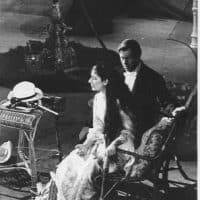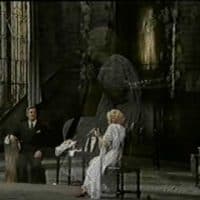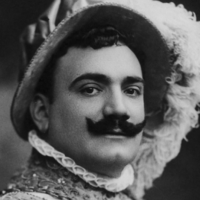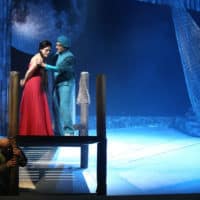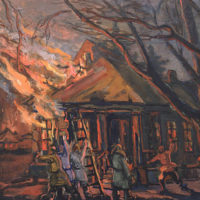This past Saturday, the Bayerische Staatsoper (BSO) provided a free, live, online stream of their current production of Mozart’s La clemenza di Tito. As I’ve previously mentioned, Clemenza is trending right now both among opera companies and the online opera fandom. It’s also close to my heart as the topic of my Master’s degree dissertation, so this was a pretty exciting event. I’m not going to write you a formal review—plenty of other people have already done that better than I could—but I’d like to reflect a little on the highlights of the production and the experience of viewing it online.
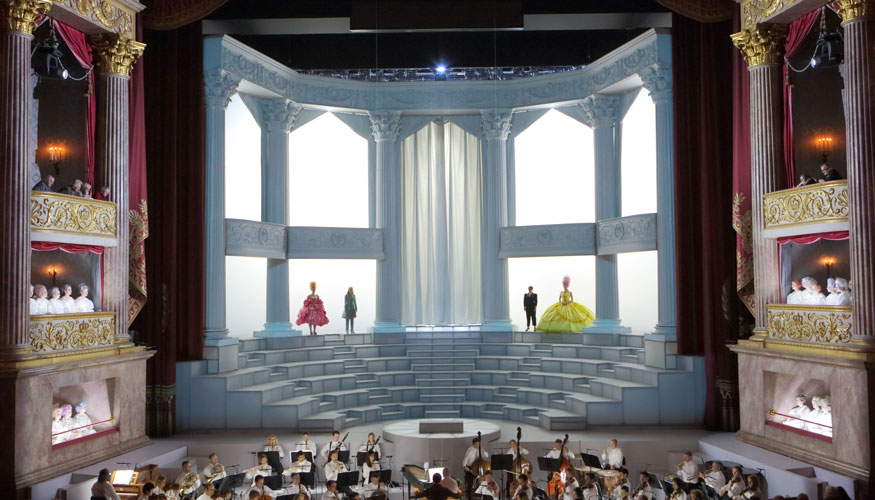
The BSO has a well-deserved reputation for crazy Regie productions, so I was a bit apprehensive about what they would do to Clemenza. The trailer did nothing to allay my fears, as it clearly showed the production’s outrageous costumes and wigs without providing enough context for me to make sense of them. Fortunately, they did seem purposeful in the actual production, which used hair and clothing to deconstruct gender in the opera.
Clemenza inherently has a lot going on, gender-wise. In a cast of six principals, there are two men playing men (Publio and Tito), two women playing women (Servilia and Vitellia), and two women playing men (Sesto and Annio). (Interestingly, at the premiere, one of the two “trouser roles” was sung by a castrato, while the other was sung by a female mezzo. Now both are almost always sung by mezzos.) The relationships between these characters complicate matters further: Although there are nominally two “couples” (Annio-Servilia and Sesto-Vitellia), there are also two very close homosocial bonds depicted (Sesto-Annio and Sesto-Tito), and many productions imply that these venture into romantic territory. (Annio and Sesto kiss at the end of their duet in the recent Paris Opera production, and Sesto and Tito are clearly in love in Alden’s staging for the Chicago Opera Theatre.) Even within the heterosexual relationships, contrary to operatic and literary tradition, it is the women who dominate and take action while the men passively accept fate or submit to the women’s desires.
I’ll mostly let the BSO’s photos (below) speak for themselves in terms of gender presentation, but here are a few observations:
- Sesto and Annio with both intentionally given a lot of fluidity and ambiguity in their gender
- Sesto’s 80s power suit was quite masculine in comparison to Vitellia’s enormous hoopskirt, but the poofy shoulders and high heels suggested femininity as well
- In act I, there seemed to be a clearly defined “more feminine” (and, synonymously, more powerful) character in each relationship. The more feminine character was generally defined by a bigger skirt and/or hairdo. So in F-M terms, the relationships were Servilia-Annio, Annio-Sesto, Vitellia-Sesto, Tito-Sesto
- Annio went from a long, skirted jacket with a long wig (act I) to a blouse, trousers, and no wig (act II)
- Sesto had a more feminine gender presentation post-arrest. Some Twitter people suggested that Sesto was trans* FTM, and that part of the abuse he suffered in prison was being forced to adopt more feminine clothing and hair

Sesto, standing behind Vitellia. While there are still feminine aspects to Sesto’s costume, the contrast is clear. Also, anyone want to guess the circumference of that hoop skirt?


Although the costumes seemed to set up interesting potential gender dynamics in the relationships, the relationships themselves seemed underplayed. During “Parto, parto,” Sesto seemed more attracted to the clarinetist (who was onstage as a character) than to Vitellia! The Sesto-Tito relationship also could have gone much further; all we got were a few awkward hugs and glances. The Annio-Sesto relationship seemed strong in the “Torna di Tito al lado” and the preceding recit, but not in their act I duettino. The one relationship that did seem clear and loving was Servilia-Annio. Their easy rapport at the end of the opera felt both contemporary and genuine.
Overall, I loved this production. The amiptheatre-like set provided a good arena for the actors and made for a the most believable fire-and-chaos scene I’ve ever seen (with sudden lighting changes and drops of set elements). The singing and acting were universally fabulous. The use of the orchestra as a character was original and inspired, even if it was occasionally a bit distracting. In fact, my only quibble was the development of the characters’ relationships; everything else was great. Most of the #operarox Twitter circle also seemed pleased:
“So into that production. A few strange eyebrow choices, and I wanted more Tito/Sesto development. But so much to chew on. #TITO” –@petrarchian
“So there’s probably nothing I don’t love about @bay_staatsoper’s #TITO.” –@SestoInfedele
“So that was fun! @TaraErraught is AMAZING. #clemenza” –@NonPiuDiFiori
Yes, two of those Twitter handles are Clemenza-themed. I did say that Clemenza was big right now.
“Twitter parties” during opera streams are a bit of an odd experience. I keep the stream in one window and Twitter in the other, and try to read and write commentary while the opera is playing. It encourages an alienated, critical stance towards the opera and production. I wouldn’t want to see an opera for the first time this way, but with a piece like Clemenza that I’ve watched at least a dozen times, it works. The novelty and emotional impact have mostly worn off, and even solo viewings tend to be detached, intellectual affairs (which can be just as fun as emotional initial viewings, in their own way). Through Twitter, I get the benefit of other enthusiasts’ interpretations and opinions in real time.
On the subject of intellectualized viewing of opera… Did I mention that my thesis is about gender and sexuality in Clemenza? This production has given me a lot to think about!
